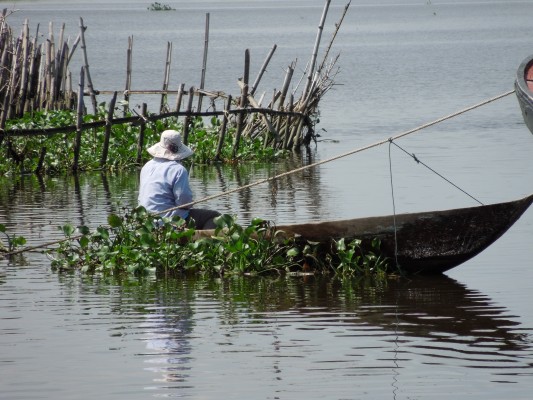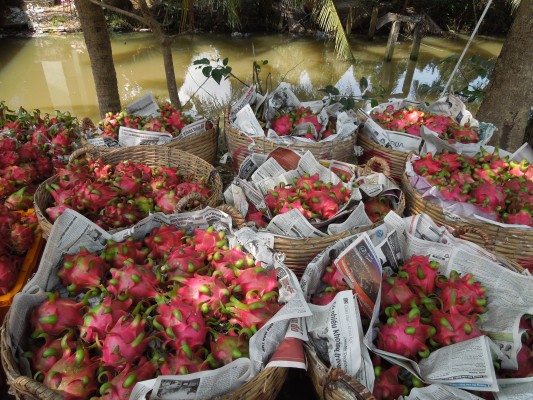It rains but not on our parade. That is, the other night it poured but not until we were returning from dinner. One morning at six, there was a downpour (even though the weather app on my iPad told me it was fair in Hoi An- so much for accuracy), but an hour and a half later, it was a glorious day.
It matters because this is a bicycling trip. There was one drizzly morning but otherwise it has been clear and so hot (ninety degrees and very humid), that when the group stops for a break, I look like a greased pig, sweat sliding off my body in sheets. The sweat mixed with sunscreen dripping into my eyes makes for very challenging navigating. We stopped by Red Beach (where the American troops landed in the War), China Beach (where they went for R&R), and one of the many areas thick with vegetation (where the Vietcong hid from them).
The terrain is mostly flat and our riding takes us through country

and seaside villages, alike.

Thankfully, the traffic is less daunting than it was in Hanoi although I feel a little intimidated when a noisy truck comes up behind me, passes too close, and then leaves a belch of black exhaust in its wake.
One thing there are a lot of are cemeteries. They are huge and seem to take up more real estate than any other enterprise. And they are beautiful.

The ordinary Vietnamese house is modest but the mausoleums are imposing with many columns and colorful tile work. There were over two million people who left the country on boats after 1975 to escape starvation and persecution. Many went to America, Australia and Canada. They were largely poor and uneducated but worked very hard at labor-intensive jobs and sent money back (hidden in umbrellas or wrapped in tobacco leaves, to avoid confiscation upon arrival) to their families who used it to build the burial chambers. This was a very important value to that generation, reverence for the dead. Now, however, according to our guides, the children of the boat people, educated and affluent, are motivated by prestige, and send back money in order to build the most impressive funeral edifices (perhaps the local version of keeping up with the Joneses!).
Our last stop, Saigon (the Vietnamese still call it Saigon even though the official name has been Ho Chi Minh City since 1976), is a world-class city.

Cosmopolitan, it is filled with skyscrapers, traffic, expensive shops and restaurants. In fact, it feels like New York to me, quite a surprise.
One day, we cycle in the Mekong Delta, the rice basket of Vietnam, through rice paddies

and dragon fruit plantations.

Another day, we ride to the Cu Chi Tunnels, the system of underground tunnels, 250 km in length, built over a twenty-year period (1948-68) by the Vietcong guerrilla fighters and used by them in the wars first against the French and then against the Americans. We had the good fortune of learning about this from Mr. Tam, a seventy year old former member of the Vietcong, who lived in the tunnels and lost an arm and an eye fighting the Americans. We then saw some of the tunnels themselves.
And amazingly, after having been on my bicycle for more than 161 miles, I find myself comfortably flowing with the traffic. There is a fluidity to the way the vehicles move with one another as though choreographed. There is something beautiful about it, like dancing, and I am thrilled to be a part of it.


Recent Comments